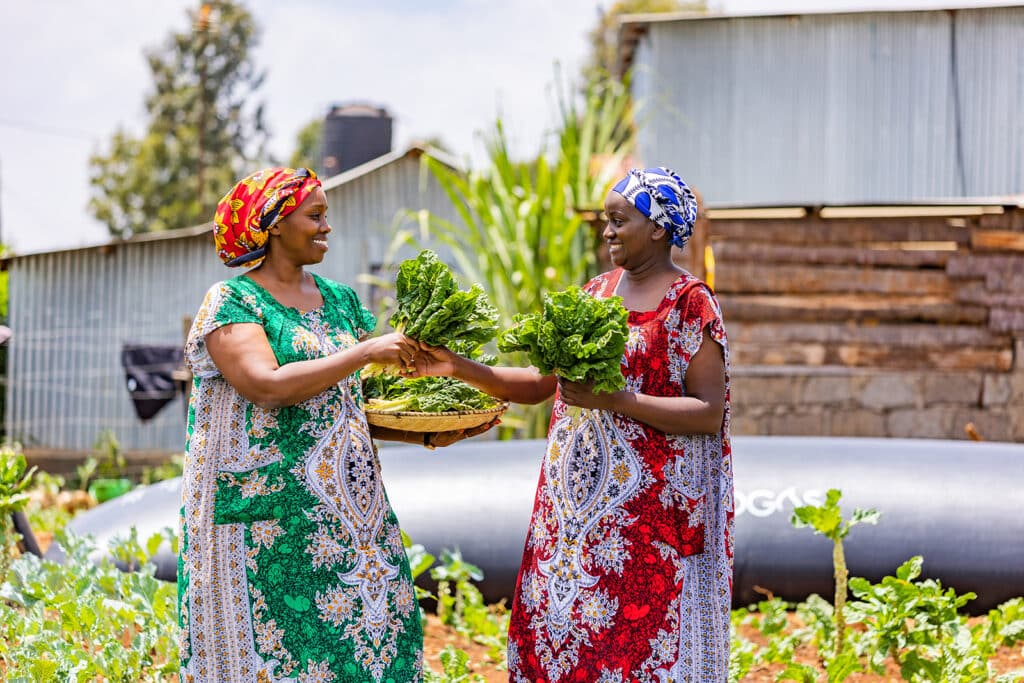
What Is a Biogas Plant?
A biogas plant is a facility that provides oxygen-free conditions where anaerobic digestion can occur. Simply put, it’s an artificial system where you can turn waste into sustainable energy and fertilizers, with positive effects on the environment.
A biogas plant has three major components that make the biogas production process possible:
- a reception area
- a digester (or fermentation tank)
- a gas holder
The reception area is where the raw materials arrive and are prepared for anaerobic digestion. Each type of biomass has a different fermentation process, so the overall length of the biogas production process varies depending on the raw materials used, and it isn’t uncommon to use pre-treatments in industrial biogas plants to accelerate fermentation and increase the production of biogas.
Some of the most popular biomass choices are crop residues, municipal and industrial sewage, agricultural material, livestock manures, seaweed, food-processing, and paper wastes, but the list of raw materials used is significantly longer.
The digester is an air-tight, waterproof container with a mean of entry for the biomass. Here, you introduce the raw materials to be transformed into energy. Then, agitators shift the biomass periodically to free the gases and prevent the formation of layers. The digester also includes a pipe that enables the digestate to be removed after the fermentation is over.
The gas holder is an airproof container, preferably made in steel, that collects the gas generated during fermentation. It’s provided with a gas outlet that permits the biogas to come out of the system and produce energy and heat.
Depending on the quantity of waste you want to eliminate from the environment or the volume of biogas you need to produce, a plant might have more than one digester and gas holders.
How does a biogas plant work?
In 2019, around 132,000 small, medium or large-scale digesters were operating globally in biogas plants that employed over 344,000 people directly or indirectly. How do these facilities work?
Biogas plants follow an automatic, straightforward process created to replicate the natural process of anaerobic digestion in an artificial environment, making biogas production simple and carbon neutral.
While some steps could vary with each biogas plant, most facilities use the same process to produce biogas. The animation below explains the process and highlights its long-term benefits.
Step 1 – Pre-treatment and filling the digester
Multiple types of organic matter, called substrates, go into the digester. Some substrates can be liquid manure, renewable raw materials (such as corn or grass), or waste produced by the food industry. Some of them may need to be stored in cement containers and pre-treated before entering the air-tight tank. One plant can include several digesters, depending on its size.
Step 2 – The fermentation process
The substrates are heated to various temperatures inside the fermenter, and a series of microorganisms start breaking down the organic matter in the absence of light and oxygen. During the process, the organic matter is shifted to prevent layers from forming at the top and bottom of the tank.
Step 3 – Producing biogas
As a result of the fermentation, biogas with methane as the main ingredient is produced inside the fermenters. At this stage of the process, the gas includes, besides methane and carbon dioxide, water and hydrogen sulfide—which is one of the main reasons containers should be made in steel, known to withstand the effects of the gas for long periods.
Step 4 – Pulling out the residues
After fermentation, the residues called digestate are pulled out of the tank to be used as environment-friendly, high-quality fertilizer. This way, the biogas production process becomes a zero-waste system of eliminating garbage from landfills while providing a solution for better crops at the same time.
Step 5 – Eliminating impurities
The biogas goes through a cleanup process, in which water, hydrogen sulfide, and impurities are removed to produce biomethane that can further be used to generate energy and heat. The biogas is permanently monitored to ensure the quality of the final product.
What is a biogas plant used for?
Biogas plants can have multiple purposes and fulfill a double role in the ecosystem and the economy. On the one hand, biogas plants can supply us with carbon-neutral energy and heating.
If the biogas plant compresses the biogas to obtain biomethane, this can substitute natural gas for industrial, commercial, and domestic uses. The fuel can be easily transported to supply gas filling stations.
Biogas is 100% renewable and carbon-neutral, as its combustion doesn’t produce new carbon dioxide. Moreover, the production process prevents the release of methane into the atmosphere, with a positive impact on the environment.
The biogas can be combusted in domestic stoves for cooking after minor treatment. Otherwise, it can be used to generate heat, produce electricity, or, in heat and power (CHP) plants, produces both heat and electricity.
The energy produced by biogas plants can be directly fed into the power grid and serve one or more communities, depending on the size of the biogas plant. Furthermore, the heat generated throughout the process can be used to heat pools or buildings.

On the other hand, producing biogas makes these facilities part of waste management programs that keep garbage from landfills. Biomass that would otherwise be released in the environment is stored and processed in ways that have minimal impact on nature. Furthermore, biogas plants can also help solve the food waste issue—globally, we lose 1.3 billion tonnes of food every year.
Last but not least, the residues are high-quality fertilizers, providing a sustainable alternative to chemical substances.
Advantages and disadvantages of biogas plants
Most benefits of biogas plants are environment-related, as they produce renewable energy for domestic and industrial use. This energy can be stored or injected into the electricity grid to reduce dependence on fossil-fuel energy, which can help reduce our carbon footprint.
In other words, biogas plants can help to fight climate change. As domestic and industrial users rely less on the energy produced with fossil fuels, greenhouse gas emissions become lower. At the same time, by gathering organic matter and controlling the fermentation process, fewer methane emissions get into the atmosphere for improved air quality.
Communities reach these results while managing food waste and preventing garbage from ending up in landfills. Recycling organic waste means fewer odors, a minimum risk for spreading diseases, and protected water bodies, among other things.
Another advantage of biogas plants is eliminating the need for synthetic fertilizers, as they get replaced by digestate. It recirculates a series of nutrients, such as phosphorus, which is essential for healthy crops.
Besides the positive effects on the environment, biogas plants contribute to building a circular economy, in which more industries can become sustainable and self-sufficient by using their waste to obtain energy or heat. As the number of facilities grows, new jobs are generated across multiple verticals, with a significant impact on the quality of life in numerous communities worldwide.
HomeBiogas: Embracing Sustainable Energy and Fertilizers
Looking to embrace sustainable energy and fertilizers? Meet HomeBiogas, the cutting-edge biogas technology for your home! Turn organic waste into carbon-neutral energy and bio-fertilizer, reducing fossil fuel dependence and greenhouse gas emissions. Join the green revolution with HomeBiogas and build a sustainable future today!

The downside?
The process is simple, but it doesn’t come cheap. The costs associated with building a biogas plant make investing in such facilities a challenge in many communities. Furthermore, the model as we know it today isn’t feasible in large, urban communities that require high amounts of energy to thrive but can’t provide the raw materials necessary for generating enough biogas.
The technology used inside many biogas plants could use an upgrade, too, to be more efficient and cost-effective. This way, biogas plants could become easily scalable, and the biogas would turn into a low-cost renewable energy solution.
Another concern around biogas production regards intentionally planted maize. Biogas production is a sustainable process as long as the raw materials used solve waste management problems. If biogas plants replace waste with energy crops, these plantations can quickly become unsustainable and even harmful to the environment.
Summary
Biogas plants and anaerobic digesters come in many sizes and forms, but they all serve the same purpose: to produce sustainable energy from waste. The biogas production process can vary with the principal raw materials treated, but overall, the steps necessary for creating biogas are similar and straightforward.
However, building a biogas plant doesn’t always come cheap, and the technology used today isn’t scalable, so progress in the industry is slow. Biogas plants aren’t scalable or feasible in large urban areas despite the multiple benefits to the environment and economy.
The industry is in its initial stage, but the number of biogas plants has grown significantly in the past years. As new technology is used to power and maintain these facilities with lower costs, we might see increased biogas production, positively affecting greenhouse gas emissions worldwide.






